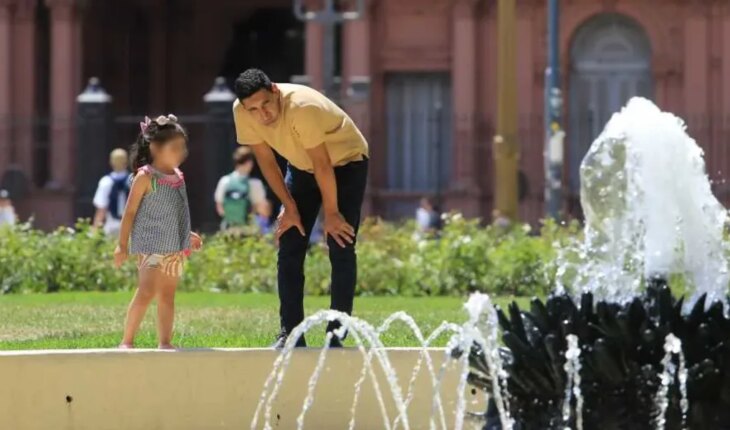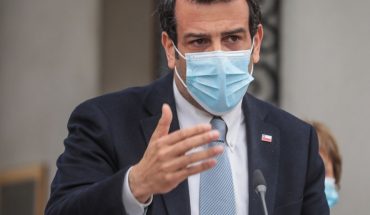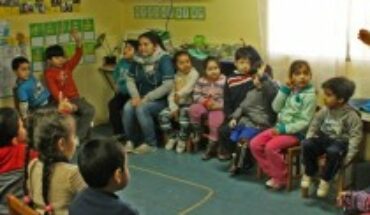The National Meteorological Service (SMN) issued a red alert for ten provinces and the Autonomous City of Buenos Aires (CABA) after a day with temperatures that exceeded 37 degrees in several locations. The red alert covers Mendoza, San Juan and La Rioja, southeast and part of the center of the province of Buenos Aires, CABA and areas of the Buenos Aires suburbs such as Avellaneda, Berazategui, Lanús, Quilmes, Ezeiza, La Matanza, Merlo, Moreno, Pilar and Tres de Febrero. Almost all of the territory of La Pampa, San Luis and Catamarca, north and east of Neuquén, west of Córdoba and north of Río Negro are also at red level.What does the red, orange and yellow alert mean? The red alert indicates that temperatures in that area are “very dangerous and can affect all people, even healthy ones”, so it is recommended to increase water consumption and not expose yourself to the sun excessively or in central hours (between 10 a.m. and 4 p.m.). Temperatures below orange “can be very dangerous, especially for at-risk groups.” The yellow level implies that temperatures will have a mild to moderate effect on health but can be dangerous, especially for at-risk groups, such as children, people over 65 years of age, with chronic diseases. Under orange alert, the rest of the province of Buenos Aires, the south of Río Negro, east of Neuquén, center, south, east of Córdoba, south of Santa Fe, west of Entre Ríos, Tucumán, east of Jujuy, northeast of Catamarca, and south of San Luis. In the yellow level are Santiago del Estero, Corrientes, Formosa, Chaco, almost all of Salta, Misiones and Santa Fe, east of San Luis, east of Entre Ríos, and north and east of Córdoba. According to the ranking of the 18 that the agency updates every hour, the hottest city in the country was Rivadavia with 41.8 degrees, followed by La Rioja with 40.8; Santiago del Estero with 40.6; San Juan with 40.2; and Las Lomitas (Formosa) with 40. The list continued with Chamical (La Rioja) with 39.4 degrees; Santa Rosa (La Pampa) with 38.7, Mendoza with 38.3; Presidencia Roque Sáenz Peña (Chaco) with 38.2; Termas de Río Hondo, Bolívar, San Rafael (Mendoza) with 38; 9 de Julio (Buenos Aires) 37.9; and San Luis and San Martín (Mendoza) 37.8; Trenque Lauquen (Buenos Aires) with 37.7 and San Fernando del Valle de Catamarca with 37.6. In CABA, the temperature reached 37.7 degrees at 2 p.m., and the agency forecast a maximum of 36 and a minimum of 27 for tomorrow; for Saturday 37 and 26 and for Sunday 32 and 22.Due to the high temperatures that Mendoza has been enduring for several days, the Ministry of Energy and Environment of the province asked the population to be cautious and alert for possible forest fires, flooding of riverbeds and thaw. “We have been communicating to the public and we will continue to do so because the province is experiencing a situation of climatological alert and we need the population to be extremely cautious,” said the Minister of Energy and Environment, Jimena Latorre, at a press conference at noon today.This Thursday, 42,015 users of Edesur and 16,895 of Edenor suffered power outages in their homes in the region of the Metropolitan Area of Buenos Aires (AMBA) due to high demand generated by extreme temperatures, according to figures on the state of the electricity service reported on the official website of the National Electricity Regulatory Entity (ENRE) at 3:05 p.m.The national electricity system today registered a new record of electricity demand by reaching 29,601 MW at 2:40 p.m. according to the records of the Electricity Wholesale Market Administration Company (Cammesa). The new peak in demand exceeds the previous all-time high for a working day recorded on March 13 last year, when the system had a requirement of 29,105 MW of power. Recommendations from the Ministry of HealthIncrease water consumption without waiting until you are thirsty to maintain adequate hydration
Do not expose yourself to the sun excessively, or in the middle of the day (between 10 a.m. and 4 p.m.)
Paying attention to infants, children, and the elderly
Avoid caffeinated, alcoholic, or highly sugary beverages
Avoiding very large meals
Eat vegetables and fruits
Reduce physical activity
Wear light, loose-fitting, light-colored clothing; Hat, sunglasses
Staying in ventilated or conditioned spaces
Remember that there is no pharmacological treatment for heat stroke and only classical methods can prevent and counteract it
Red alert in 10 provinces: what it means and recommendations
February 1, 2024 |





